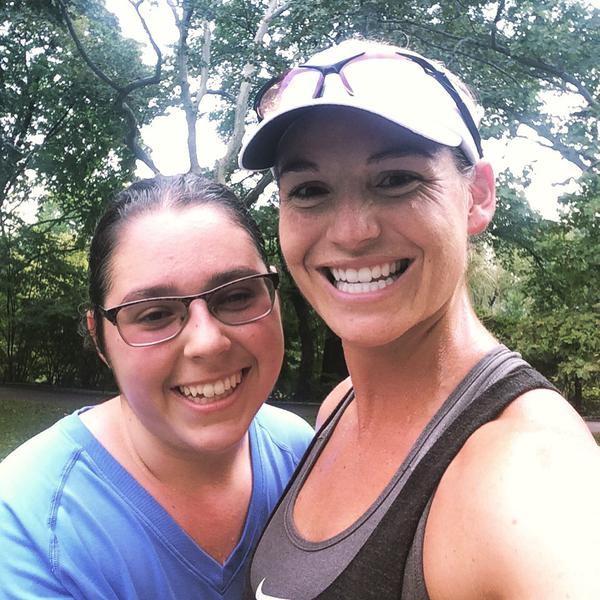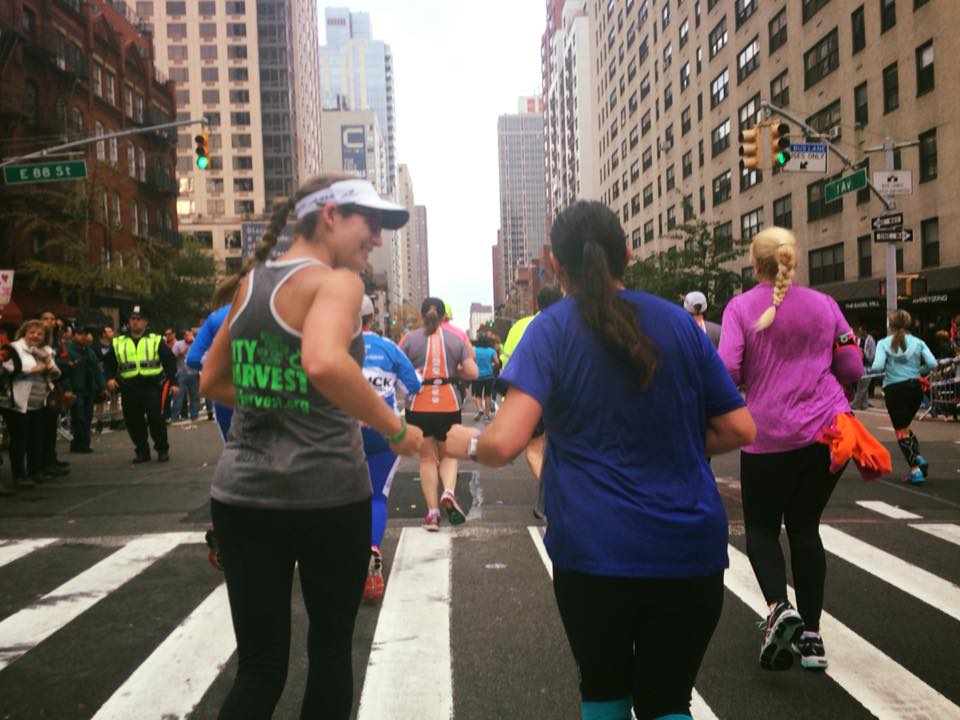One of the greatest joys of my job is watching my athletes succeed. I get to watch them from the first day of training all the way through to their goals, witnessing the transformation that the months of hard work, dedication, and drive always deliver. On Sunday, November 2nd, between private clients, the City Harvest Charity Team, and runners who have been sweating it out at Mile High Run Club, I had over 100 runners stepping up to the starting line of the NYC Marathon. Many times, my work is done come race morning. I am left to frantically track my runners via numerous laptops and phones, or on the course cheering as my runners pass by. This year my work was a little different – I had the responsibility of pacing one of my private clients for her 26.2 mile journey.
As one might imagine, pacing a runner to their goals is a huge responsibility. It is also an honor. And it’s a completely different game to pace a pace group – simply locking in and holding a pace. When with one runner, you are with them through good and bad, needing to make modifications, judgement calls, and offer a ton of emotional support. Sometimes you need to talk them through the wall, force them to a medical tent, give them a shoulder to literally lean on, take walking breaks, try to make them laugh and think of happy thoughts, share their tears of pain and frustration. It’s always a journey of highs and lows, and you hope the highs outweigh the lows.
On Sunday, I had the job of pacing a first-time marathoner. She is only be 20 years old. I don’t know about you, but I know very few 20-year olds who run marathons. She also earned her way into the marathon via NYRR’s 9+1. She also happens to have a cognitive disability. She is incredible, and trained incredibly hard to get to Sunday’s starting line.
When I arrived at her door, I was greeted with the biggest hug and lots of excitement. Imagine a child on Christmas morning or at Disney World, and that’s perhaps close to the enthusiasm Shira had for race morning. I wish every runner was as excited to run 26.2 miles as this young lady!
Unfortunately, the day faced us with some really tough challenges: a delay on the Staten Island Ferry, a HUGE delay with the shuttle from the ferry to Athlete’s Village – so much so that we barely had time to get to our corral before it closed. Because of the delays, we both missed our opportunities to grab bagels, or even find the special tent we had been granted access to. Our very long and delayed trip to the starting line was overwhelming, and that caused the wheels to come off during the race. However, some fantastic support out there from Shira’s parents, relatives, teachers and friends were exactly what we needed to continue moving forward. At times we ran. At times we walked. We stopped for bananas twice, because Shira was starving. We stopped at a medical tent so that a medic could massage Shira’s tight quad. We stopped when we saw her family, so that she could facetime with her sister who was in Israel on Sunday. Through highs and lows, the miles ticked by.
What struck me the most was the support of the other runners out there. They were so supportive of her, often cheering her on, echoing my encouraging words, and giving her high-fives. While the crowded course for the first few miles was very overwhelming (I do not recommend someone with special needs to be in the last wave – it was too much for her), the runners around us were sometimes what got her through to the next mile.
Despite the difficulties, the minute we crossed the finish line after 5 hours and 38 minutes of being on our feet, Shira was elated. She was so proud of herself – and rightly so! Her strength is an inspiration to me and everyone who knows her.
Here are a few of my observations from the 2015 NYC Marathon:
- In wave 4 (cannot speak for the other waves), many runners stop with their phones and selfie sticks for photos along the course – especially within the first mile as we go up and over the bridge. This was not only extremely frustrating, but also dangerous. In my humble opinion, cell phones have negatively impacted the race experience. Make memories and let the race photographers handle the photos.
- Runners with special needs should not take the ferry – our morning included: a subway, a shuttle (subway had construction), a ferry, a shuttle, a walk. That’s a LOT of logistics/stress to handle. That wasn’t fair for Shira.
- The race starts with cannons. If you were at the finish line of the Boston Marathon in 2013 and happened to forget that NYC marathon begins with cannons, you might jump out of your skin. You can guess how hard it was for me to keep my cool when that happened. I almost threw up.
- There were hardly any porta-potty lines in our corral. That was pretty amazing.
- Bagels/refreshments were nowhere near our village/corral. This was pretty awful.
- The volunteers along the course were supportive and energetic.
- At the finish line, we had a wrist band and permission to exit where the elite runners and Achilles athletes exit at west 72nd street. The NYRR staff would not allow us to exit, which was unfortunate considering all the extra work we had put into making Shira’s day as comfortable as possible – which had included months of correspondence with the folks at NYRR.
- New Yorker’s are the nicest, most considerate people on marathon day. Suddenly everyone is supportive, smiling, and ready to help a runner any way possible. I wish that humanity would carry through the rest of the year.
Kathrine Switzer once was quoted saying “If you ever lose sight in human nature, go out and watch a marathon.” I agree. You see people at their most raw. You see blood, sweat and tears, and the will to push forward. You see human beings at their best and their worst – sometimes all at the same moment. If you ever feel dull and have the desire to feel “alive,” train and run a marathon.
After I left Shira’s apartment and headed towards an after party with my charity team, I was slowly able to start the process of checking results for all my other runners. My phone was flooded with emails, texts, missed calls, instagram photos, twitter updates – all from my athletes. It was amazing. The marathon is bigger than any one person, and perhaps that’s part of what makes it so epic.






